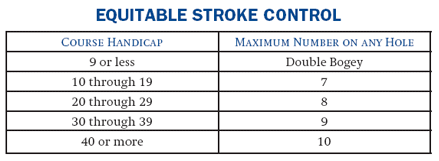Answers to Most of Your Handicapping Questions Can be Found Right Here
The following are a collection of Handicap System questions, which are frequently asked to staff within the GHIN Department. Click on a question and the appropriate answer will appear. Should you have any further questions, please feel free to contact our GHIN department.
General Handicapping FAQ's
- How do I establish a USGA Handicap Index?
- What should a player do if he/she does not finish a hole or is conceded a stroke?
- What is the current method for adjusting my hole scores under Equitable Stroke Control?
- What should a player do if he/she does not play a hole or does not play it under the principles of the Rules of Golf?
- Should a player post a score during his/her home club's Inactive Season?
- What scores are acceptable for posting purposes?
- When players are competing from different sets of tees, why do you make a second adjustment?
- Can strokes be subtracted when applying Section 3-5?
- Does the USGA have any recommendations for allocation of Handicap Strokes?
GHIN Specific FAQ's
- I have made a mistake posting a score online, how can this be fixed? Or there are multiple entries with the same date in my scoring record.
- I am a member of a golf club and posted scores online. When I tried to look up my handicap today, I received a response of, "GHIN number not found." I checked the number from my card and it is the correct number. Is there something wrong?
- I would like to find a club in my area that offers the GHIN handicap system.
- I was just added to the GHIN system, when will I have an official handicap?
- My club recently assigned me a GHIN number. Should I be able to see my Handicap Index and/or post online immediately?
- When should I be able to see my Handicap Index?
- I am trying to post a score online but it will not give me the correct date on the website.
- I posted a score online today, but could not see that score. What happened?
- I have two different GHIN numbers, what should I do?
- Can I to look up a Handicap Index for anyone in the country who has a Handicap Index?
- Our club is currently on GHIN and I need to order supplies for the program.
- The club I represent is interested in converting to the GHIN handicap system.
How do I establish a USGA Handicap Index?
You must be a member of a golf club. The USGA defines a golf club as an organization of at least ten individual members that have a reasonable and regular opportunity to play with each other, that operate under by-laws, that provide for peer review and have a Handicap Committee. Therefore, a golf club can be anywhere either at a public course, a private course, a business, a neighborhood, etc. You do not need a specific course to be considered a golf club by the USGA; however, you do need to meet the above requirements.
What should a player do if he does not finish a hole or is conceded a stroke?
If a player does not finish a hole or is conceded a stroke then, he must record his most likely score. Most likely score is the number of strokes already taken, plus in the player's best judgment, the number of strokes needed to complete the hole from that point more than half the time.
The most likely score should have an "X" preceding the number. For example, player A is just off the green in 2 strokes, and his partner just holed out for a 2; therefore, player A decides to pick up. What should player A record on the scorecard? Player A determines he will most likely chip up and two putt; therefore, player A will record an X-5 on the card. (2, already taken, + 3 to complete the hole). Player A does not automatically put down his ESC maximum. First, he determines his most likely score and then after the round checks to see if the most likely score is above his ESC limit. In this case, player A has a Course Handicap of 24 and his maximum is 8. X-5 is not above his limit and therefore, X-5 is the score he must use for posting purposes. For further information on most likely score please refer to Section 4-1 of the Handicap System Manual.
What is the current method for adjusting my hole scores under Equitable Stroke Control (ESC)?
ESC is an adjustment of individual hole scores (for handicap purposes) in order to make handicaps more representative of a player's potential. ESC is used after the round and is only used when the actual score or the most likely score exceeds his maximum number. ESC sets a limit to the number of strokes a player can take on a hole depending on his Course Handicap. ESC applies to all scores, including tournament scores. Below is the maximum number a player can take:

Please refer to Section 4-3 of the USGA Handicap System Manual.
What should a player do if he does not play a hole or does not play it under the principles of the Rules of Golf?
For Handicap Purposes, the player must record par plus any handicap strokes for those holes not played. For example, player A is not able to play holes 16, 17, and 18 due to darkness. Player A has a Course Handicap of 12 and holes 16, 17, 18 are a par 5, 3, 4, and are allocated as the number 4, 16, 10 handicap holes respectively. Therefore, player A will record an x-6, x-3, x-5 on holes 16, 17, and 18 respectively. Please refer Section 4-2 of the Handicap System Manual for more information.
Should a player post a score during his/her home club's Inactive Season?
Some state and regional golf associations set active and inactive seasons for clubs to follow in their area. If a round is played on a course that is observing an inactive season, that score is unacceptable for posting for handicap purposes. However, if a member of a golf club, which is observing an inactive season, plays at a course observing an active season, that score must be posted to the scoring record. For example, if a member of a golf club in Michigan plays golf in Florida in January, the scores from Florida are acceptable, and will be returned to the club in Michigan. The player has a few options when posting the score. First, the player might be able to post as a guest if the two clubs use the same computation service. Second, the player might be able to post the score using the IGN network, if the state associations are members of the IGN network, and the score will be routed back to his home golf club. Third, the player can keep a copy of the score and the ratings and post when he returns to his home course no later than the start of his active season. Please refer to Sections 6-2 and 8-3c and Handicap Decision 6-2/1 of the Handicap System Manual for more details on Inactive Seasons.
What scores are acceptable for posting purposes?
Almost all scores are acceptable because of the basic premise of the Handicap System which is every player will try his best at every hole, in every round regardless of where the round was played. Therefore all of the following are acceptable scores:
- 18 holes
- 13 or more holes
- Consecutive and in some regions, non-consecutive nine-hole scores
- Scores on all courses
- Scores in all forms of competition: match play, stroke play, team competitions
- Scores made under the Rules of Golf
- Scores played with preferred lies
Please refer to Section 5-1 of the Handicap System manual for more information on acceptable scores.
When players are competing from different tees, why do you make a second adjustment?
Many players question the application of Section 3-5, where players are competing from different sets of tees, or men and women are competing from the same set of tees. This is a difficult concept to understand and we are offering a few different ways to allow you to explain this to your club members.
We need to define what the Slope Rating does, as many players think the different Slope Ratings automatically take care of the difference in the two sets of tees. This is a myth. The Slope Rating is used to convert a Handicap Index to a Course Handicap, which allows the player to receive the number of strokes he needs to play to the level of a scratch golfer for that particular set of tees. In other words, it is the number of strokes he needs to play down to the Course Rating for that particular set of tees.
Example:
Player A: Handicap Index of 10.4
White set of tees: Course Rating of 71.1 and a Slope Rating of 130.
Course Handicap for player A on the white tees is a 12 (10.4 x 130/113).
He needs 12 strokes to play down to the level of a scratch golfer on the white set of tees. The scratch golfer is what the Course Rating is based upon, so that is 71.1. For the Course Handicap of 12 to play down to the level of a scratch golfer, he would need to shoot 71.1 + 12, or 83.1, which we will round to 83. So, if player A plays to his Course Handicap by shooting 83, he would tie the scratch golfer shooting 71 on the white set of tees. Now, we have found a way for a golfer to compete against a player with a different skill level from a specific set of tees.
Player B: Handicap Index of 10.4
Blue set of tees: Course Rating of 73.2 and a Slope Rating of 140.
Course Handicap for player B on the blue tees is 13 (10.4 x 140/113).
Player B needs 13 strokes to play down to the level of a scratch golfer for this particular blue set of tees. As we said earlier, the scratch golfer is what the Course Rating is based upon, and on the blue set of tees that is 73.2. For the Course Handicap of 13 to play down to the level of a scratch golfer, he would need to shoot 73.2 + 13 or 86.3, which we will round to 86. So, if player B plays to his Course Handicap by shooting 86, he would tie the scratch golfer shooting 73 on the blue set of tees. Great, again we have found a way for a golfer to compete against a player with a different skill level from a specific set of tees.
So now the two non-scratch players decide to compete against one another; Player A from the white tees and Player B from the blue tees. We have determined their Course Handicap when they were going to play someone else from the same set of tees, but that is no longer the case. However, we have already determined that player A needs 12 strokes to play down to a scratch for the white set of tees and player B needs 13 strokes to play down to the level of a scratch player for the blue set of tees. If both players play exactly to their Course Handicap, player A scores 83 for a net of 71 and player B scores 86 for a net of 73. Player A wins every time if they shoot to their Course Handicap, as 71 is better than 73. This is because the Course Handicaps were set up allowing each player to score down to the level of the scratch golfer for the specific set of tees they are playing. SLOPE allows one to compete with someone from the same set of tees, but in our example the players are not playing the same set of tees.
Now, we have to standardize/equalize the Course Ratings in order for the two players to compete equitably. The same thing would apply when two scratch players chose to play from these two different sets of tees. A scratch golfer would shoot a 71 from the white tees and another scratch golfer would shoot a 73 from the blue tees. Because the player playing the blue tees is playing a course with a higher Course Rating (more difficult set of tees), we must equalize the difference in Course Ratings in order to do any type of comparison or competition. This applies to every golfer, no matter what their level of skill, as all the Slope Rating has done is given a player enough strokes to play down to the level of a scratch for the specific set of tees.
Back to our net players A and B. Because player B is playing a set of tees with a higher Course Rating, we must add the difference between the two Course Ratings to his Course Handicap if he is going to compete with someone else from a different set of tees. 73.2 (blue) - 71.1 (white) = 2.2, which we round to 2. So player B will add two strokes to his 13, resulting in a Course Handicap of 15. Now let's look at the competition if both players score to their Course Handicap:
Player A Player B
| Target Score | 83 | 86 |
| Course Handicap | -12 | -13 |
| Difference in Rating | -2 | |
| Net Score | 71 | 71 |
We have reached our desired goal. Both players have scored to their Course Handicap and their net score results in a tie.
Common thoughts:
- My Handicap Index converts to the same Course Handicap from two different sets of tees. This system must be messed up because I definitely score higher on the longer set of tees and I need more strokes. Example, a player has a Handicap Index of 10.4. The white set of tees has a Course Rating of 70.9 and a Slope Rating of 118. The blue tee has a Course Rating of 73.1 and a Slope Rating of 122. In both cases 10.4 converts to a Course Handicap of 11. As we learned in Example 1, the Slope Rating allows us to receive enough strokes to play to the level of a scratch golfer from a particular set of tees. So, when this player plays the white set of tees, he needs 11 strokes to play down to the Course Rating of 70.9. When he plays the blue set of tees, he needs 11 strokes to play down to the Course Rating of 73.1. So, to play to his Course Handicap, he needs to score 70.9 + 11 = 81.9 or 82 from the white tees and 73.1 + 11 = 84.1 or 84 from the blue tees. The system recognizes the difficulty difference in the two sets of tees, but it doesn't show up until we take into account both the Course Rating and the Slope Rating.
- A player develops a Handicap Index from a certain set of tees, so a 10.4 who plays all the time from the blue tees is better than the 10.4 who plays from the white set of tees. Another way to read this is that a player develops a Handicap Index from a specific set of tees. In our last example, we said the white tees had a Course Rating of 70.9 and a Slope Rating of 118. What would a player have to average with his ten best scores/differentials to become a 10.4? Let's skip the 96 percent factor in the formula to make it easier to determine. First, we need to determine how to calculate a handicap differential. It is the adjusted gross score minus the Course Rating multiplied by a 113 STANDARD for Slope Rating, divided by the Slope Rating of the tees played. 81.8 - 70.9 x 113/118 = 10.4. So if a player averaged 81.8 on his ten best differentials, the result would be 10.4. If a blue tee player averaged 81.8, the result would be 8.1 (81.8 - 73.1 x 113/122). Result: Shooting the same score from different sets of tees does not result in the same Handicap Index. For a player averaging 84.3 from the blue tees, the resulting Handicap Index would be 10.4 (84.3 - 73.1 x 113/122). The combination of the differences in Course Ratings, plus the weighting of the Slope Rating shows that a blue tee player averaging 2.5 strokes higher than the white tee player would result in the same Handicap Index. This is how we determine which ten rounds to count in your Handicap Index, whether played from the blue tee at your course, the white tee at your course or the blue tees at Pebble Beach.
Nowhere in the above information did we mention the word par. Players often try to throw par into the mix when trying to figure if scores are equal. Par is of little relevance in the handicap system and is a terrible indicator of predicting score. For example, one course may be 5500 yards long and have a par of 72 and another may be 7200 yards long and have a par of 72. It is highly unlikely that scores on these two courses would be equal for any level of golfer.
In each of the examples, we have used both Course Rating and Slope Rating. The point is that Slope Rating by itself has little meaning within the Handicap System. There must be a Course Rating standard to connect/attach to the Slope Rating in order for there to be any meaning. If there is one thing to remember from all of this, it is that the Slope Rating is used to convert a Handicap Index to a Course Handicap, which allows the player to receive the number of strokes he needs to play to the level of a scratch golfer for that particular set of tees.
Can strokes be subtracted instead of added when applying Section 3-5?
The USGA does allow the Committee to decide whether they may add or subtract the difference in rating in cases where players are playing a lower-rated set of tees since the overall effect will be the same.
Does the USGA have any recommendations for allocating Handicap Strokes?
The USGA recommends that the Handicap Committee should review the course hole-by-hole to determine the appropriate allocation of handicap strokes for men and women. This procedure is not mandatory and will have minimal effect on a player's handicap. Common sense should be used to ensure that the handicap strokes are used as an equalizer and should be available where it most likely will be needed by the higher-handicapped player in order to obtain a halve on the hole.
When starting out, the Handicap Committee should remember a few basic guidelines:
- Allocate strokes based on the tees played most often by a majority of the members.
- Allocate the odd-numbered strokes to the first-nine holes and all the even-numbered strokes to the second nine holes, unless your second nine is decidedly more difficult than you can flip flop the odd and even numbered strokes.
- Avoid allocating the low numbered holes to the beginning or end of the nine holes.
A method for allocating your handicap strokes is to collect 200 scorecards from two different groups and compared the average hole score for group A against the average hole score for group B. Group A is your lower handicapped players (0-8 for men or 0-14 for women). If there are no members within this range then take the low 25% of the members as your group A. Group B is your middle to higher-handicapped players, at least an average of 15-20 strokes higher than group A. (20-28 for men and 26-40 for women). The greater the difference between the groups the lower the handicap stroke hole will be. Some adjustments can be made once the results are in. Again the Handicap Committee should use good judgment when allocating handicap stroke holes. Please refer to Section 17 of the Handicap System manual for more detailed information.
GHIN handicap system specific FAQ's
I have made a mistake posting a score online, how can this be fixed? Or there are multiple entries with the same date in my scoring record.
Please notify your GHIN club of any errors in your scoring record and they will be able to correct them for you.
I am a member of a golf club and posted scores online. When I tried to look up my handicap today, I received a response of, "GHIN Number not found." I checked the number from my card and it is the correct number. Is there something wrong?
Many clubs "inactivate" their rosters when a new season or year starts. This prevents the club from accidentally being billed for someone who is not returning to the club this year/season. Most often, a visit to your club and payment of membership fees for this year/season will get the ball rolling. The club will then activate your record. Until the club activates your record you will not be available on GHIN.com.
I would like to find a club in my area that offers the GHIN Handicap System.
Please call our office at 813.632.3742 and we will be able to provide you with the names of some clubs in your area that offer the GHIN Handicap System.
I was just added to the GHIN system, when will I have an official handicap?
Assuming you have at least 5 scores in your scoring record, handicaps are updated on the first and fifteenth of every month in Florida.
My club recently assigned me a GHIN number. Should I be able to see my Handicap Index® and/or post online immediately?
Yes, assuming your club allows online score posting you will be able to post scores immediately.
When should I be able to see my Handicap Index®?
Your Handicap Index® is updated according to a revision schedule set by the regional golf association in your area. The general handicap lookup is a snapshot of scores that were in your scoring record prior to that effective revision date. So, if you were added on June 10, but the last revision in your area was June 5, then no Handicap Index® will appear on GHIN.com until after the next revision, but recently posted scores can be accessed via the "View 20 Most Recent" link.
I am trying to post a score online but it will not give me the correct date on the website.
Please adjust the time and date on your computer by right clicking on your time display, this will fix this error.
I posted a score online today, but could not see that score. What happened?
The initial Handicap lookup screen is a snapshot tied to a revision date - that screen will not show recently posted scores. However, if you click on the image link entitled "View 20 Most Recent" just above your scoring record, you will see a snapshot of what is in the database at this moment. The score that you posted online should appear there.
I have two different GHIN numbers, what should I do?
Please contact Kevin Kasubinski at our office with both GHIN numbers and he will merge the two accounts for you. Please include which GHIN number you would like to keep active.
Can I look up a Handicap Index® for anyone in the country who has a Handicap Index®?
No. There are many computation services assisting in the issuance of a Handicap Index®. The GHIN database is comprised of golfers using the GHIN service.
Our club is currently on GHIN and I need to order supplies for the program.
Please email Kevin Kasubinski and he will be able to complete your supply order.
The club I represent is interested in converting to the GHIN handicap system.
Please contact Kevin Kasubinski at the FSGA office, and he will be able to provide you with the information you need to convert to the GHIN handicap system and be a full member club of the FSGA. The number is 813.632.3742.






